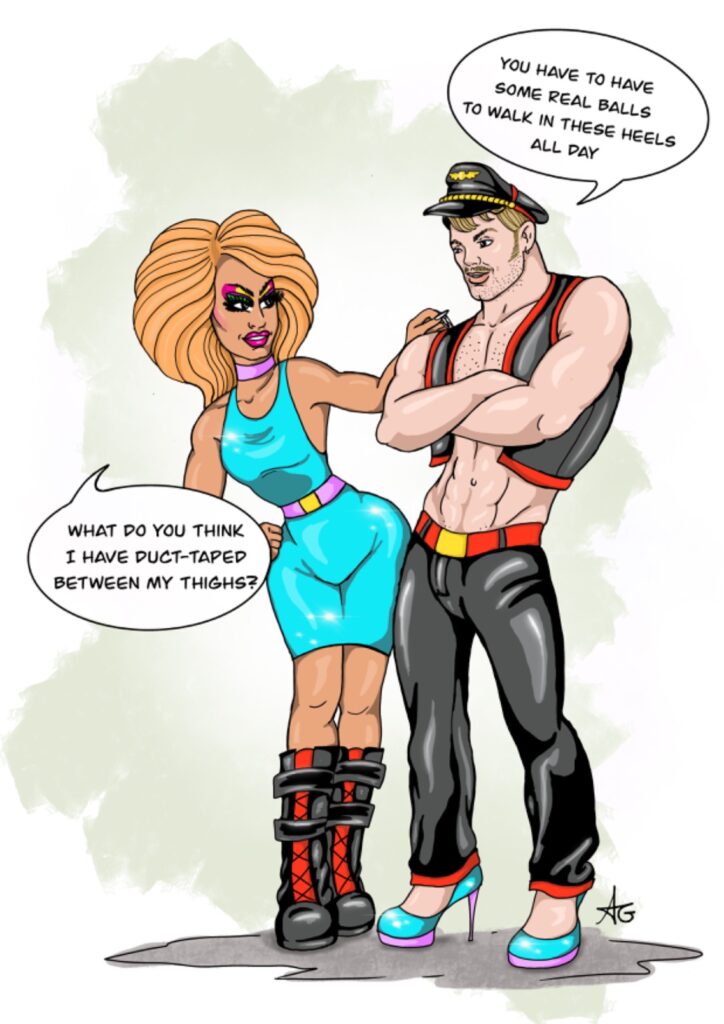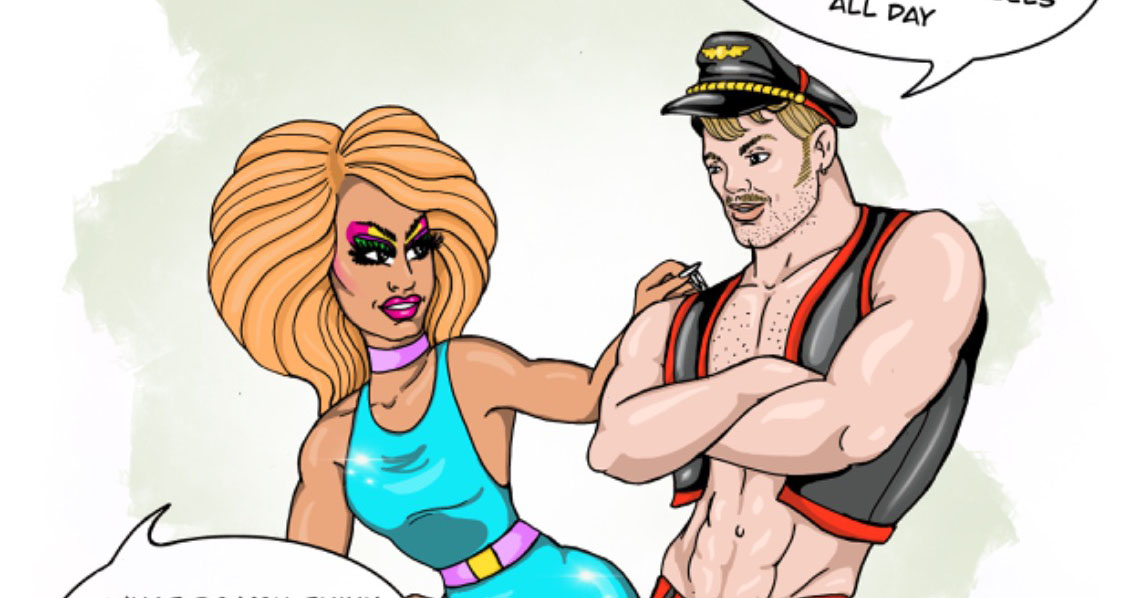Recently, I was speaking to a fetish drag queen who told me that she felt particularly unwelcome in the leather community. But was this a fair assumption? How different are the drag and leather communities? And is wearing leather gear not just another form of drag? I thought I’d look into it.
In contrast to the heteronormative and rather hegemonic world in which we all live, Planet LGBTQA+ is – as the abbreviation suggests – full of diversity and satellite or subcultures that challenge masculinity, femininity, and sexuality in general. Although some of these blend together and intertwine, leather and drag, at first glance, seem to be complete opposites. But, as the song goes, opposites not only attract but also share lots of things in common sometimes.
If you paid attention at school, you’ll know that William Shakespeare often toyed with cross-gender performances in the 16th and 17th centuries, but men had already been dressing up as women for centuries before that. Because women weren’t allowed to perform in the theatres of ancient Greece, men had to wear women’s clothes to play female roles – a societal rule which actually lasted for hundreds of years. In fact, the term “drag” was first coined by male actors who complained about their heavy women’s skirts dragging along the floor. Drag wasn’t just limited to the stage, though, and for many years it was an accepted custom for first-time sailors to dress up in women’s clothing when their ships crossed the equator. There’s even film footage from the Second World War showing Allied soldiers in drag manning cannons because their troop entertainment show had been interrupted by enemy fire. Although there have always been patriarchs who condemned men in dresses, drag was publicly tolerated over centuries as nothing more than harmless, morale-boosting entertainment in the absence of women. The term “drag queen” wasn’t coined, however, until 1888 when the former slave William Dorsey Swann – known as “Her Majesty” – resisted arrest for wearing dresses in Washington D.C. Dorsey became known as the first LGBTQ activist, and from that time on, drag became definitively associated with homosexuality and all gay men were believed to be secret, effeminate cross-dressers.
It was exactly this prejudice that gave rise to the leather community. The American GIs returning home from the war-torn battlefields of Europe in 1945 wanted nothing to do with this over-effeminate misconception of homosexuality of the previous decades. Many of them, who had experienced their first gay sex in the military, missed the all-male camaraderie, tight uniforms, hierarchy, respect, and discipline. Leather gear offered an alternative to petticoats and wigs; it was rebellious, rugged, powerful, erotic, and exemplified a hypermasculine stereotype. Motorcycle clubs provided men-only spaces to connect and, when Tom of Finland’s sketches quickly spread around the world, gay men everywhere felt empowered to reclaim their masculine identity by adorning leather clothing. This was the first time in history that homosexual men could represent themselves as “real” men instead of as a bunch of “pansies”.

Nonetheless, these differences go deeper than a layer of clothing. Whereas drag queens have historically celebrated their inner-femininity, leather men have chosen to completely reject it. Where a drag queen might proudly and loudly present her latest ultra-modern sequinned creation during an innovative stage performance, most leather men might claim to prefer a more conservative and traditional male-idealised lifestyle. Probably the biggest difference for me personally – a man of leather as well as a person of colour – is the intercultural make up of both groups. In a study on drag queens published in the Journal of Homosexuality in 2007, two thirds of the participants were people of colour, a complete contrast to the still predominantly white European leather community. Additionally, although I’d hate to burst your bubble, you don’t have to be a gay man to wear drag, but as the term suggests, you must be a gay male to be a leather man. Ultimately, drag is merely a show of exaggerated glitz and glamour, but leather is for many men both a sexual identity and a way of life.
Gender identification is, in fact, an important theme when it comes to drag queens and leather kings. Despite all the make-up and the mega-high heels, drag queens don’t actually want to be seen as women and we must be careful not to confuse drag with transgenderism. Even RuPaul has denied impersonating women: “How many women do you know who wear seven-inch heels, four-foot wigs, and skin-tight dresses? I don’t dress like a woman, I dress like a drag queen.” I’m quite certain, though, that every leather man most certainly wants to be considered masculine. After all, the tight leather clothes that enhance a man’s best assets like a second skin belong to our biggest turn-ons. Maybe one reason why so many leather guys may potentially reject drag queens is exactly because they prefer a masculine representation over a feminine one. The European leather community, at least, is known for its lack of gender integration and is therefore often considered misogynist. For men who subscribe to a traditional, hypermasculine Weltanschauung, the female is weaker, softer, and inferior – as are those who dress like them.
Despite all these differences, leather men and drag queens actually also have a lot in common. Not only do they both offer opposing forms of queer identity and aesthetics but, for many gay men, it’s simply a preferred weekend outfit for having fun in the bars. From our own experiences in public, most leather men know how quick other people are to judge outward appearances, but drag says no more about someone’s personality as a leather uniform does. Instead, both communities are marginalised, stigmatised, and considered sexually deviant – not only by mainstream society, but also within the gay community. Regardless of the crowds we encounter every year at Folsom Europe, both leather men and drag queens actually represent a gay-scene minority. And as it’s usually left to minorities to instigate change, it was the joint side-by-side effort of drag queens and leather guys at the Stonewall riots in 1969 that eventually led to the freedoms we enjoy today.
I don’t know how often I’ve literally dragged a wrist-breaking suitcase full of leather around the world to various fetish events, which is also a common complaint amongst many of my leather friends. Perhaps we shouldn’t use such phrases so lightly, in case they stick, and people actually do start referring to leather as drag – at the end of the day, that’s all it takes to coin a phrase! Nonetheless, as a man of leather who has never worn drag (yet!), I think the leather community must learn to embrace difference if it wants to properly survive. The world we occupy now has little to do with James Dean’s leather years of the 1950s, and one of the male’s biggest weaknesses – and vulnerabilities – has always been the inability to welcome change and adapt to new flows in society.
Gen Z, roughly the generation of people born in the first decade of this century and thus far removed from the full-uniformed years of WW2, is used to a highly intercultural and interconnected world. Twenty-first-century people are gender fluid, dress more casually, and naturally comprise all skin colours and international backgrounds. Young people experimenting with gender and sexuality today have different expectations, which I’m not sure the leather community yet fully accepts. The puppies are already rubbing our noses into it, presenting us with a new concept of less rigid masculine attitudes towards leather and fetish and, once we acknowledge this, then maybe it’s time to also extend our manly hospitality to fetish drag queens.
Finally, because one thing never undoubtedly excludes another, I personally know a couple of the biggest leather guys in Europe who also deliver fantastic drag shows when they’re not hanging out in chaps and jockstraps! So, whether you wear breaches or dresses on a Friday night, it will never be your clothes that define you, but instead only what’s in your heart.




